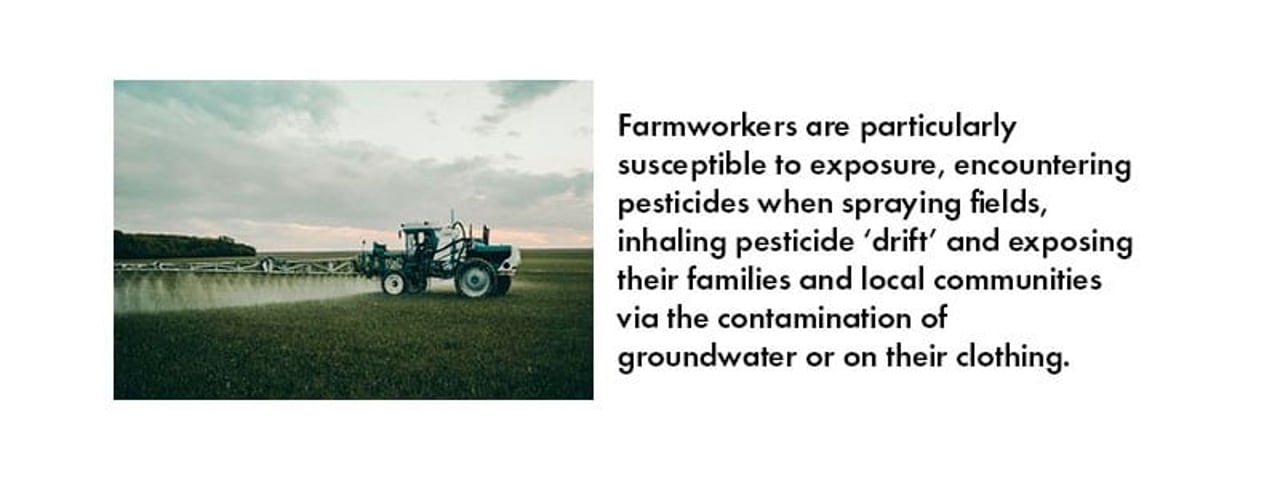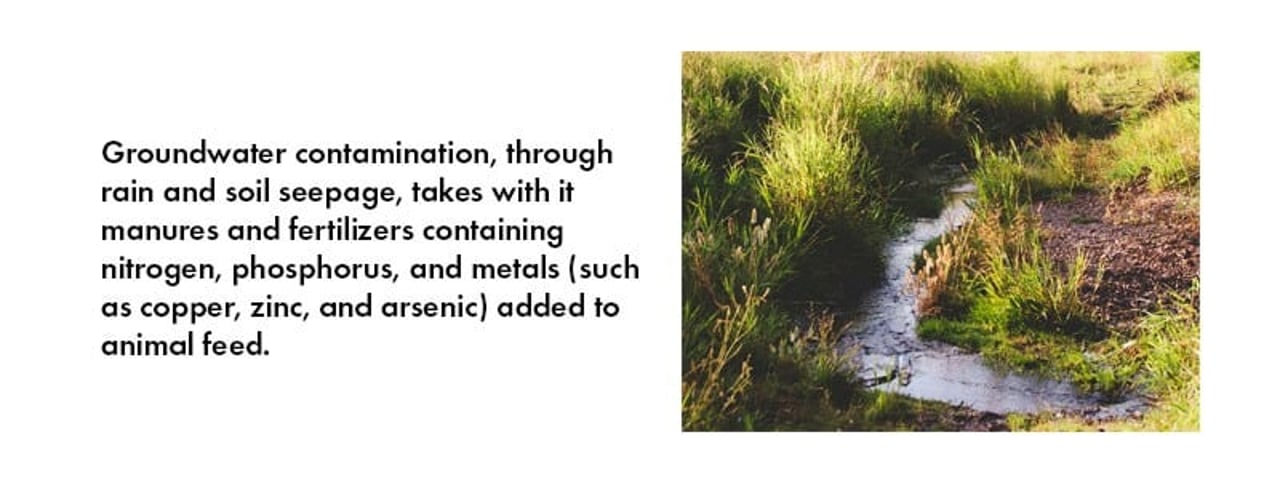
Factory farming methods rely heavily on using pesticides to protect plants from pests and diseases. These contaminants pollute our environment and damage our health.
In this blog we explore how industrial agriculture systems contaminate the environment and the ways in which that environmental pollution impacts people’s health and well-being.
The main types of environmental pollutants include:
- pesticides
- hormone growth promoters
- fertilizers
- air pollution
- greenhouse gases including methane, nitrous oxides, and carbon dioxide.
Environmental impact of pesticides
Factory farming methods rely heavily on using pesticides to protect plants from pests and diseases.
On the plus side, pesticide products help farmers to maximise the amount of food they can produce on their land by reducing crops lost to disease and pests. The United Nations Food and Agriculture Organization estimates that 26% to 40% of crops are lost every year to weeds, pests and disease.1
On the negative side, they can pollute the air, soils, and water courses, contaminating the foods we eat. Monoculture corn and soy plantations, three quarters of which ends up as animal feed for the meat industry, are dependent on pesticides and their fields dominate many farming landscapes.
More than one third of the pesticides sold by the top five companies are substances that are classified as ‘highly hazardous’ to human health, wildlife, or ecosystems.
The health impact of pesticides
Many pesticides contain endocrine-disrupting chemicals (EDCs), that mimic or interfere with the human body’s hormones. They are wide-spread across our food systems and are now recognised as serious and urgent threats to public health, emerging as one of the leading global environmental risks.2
EDCs can also be found in hormones used in meat, poultry, and dairy production and compounds used as food preservatives.3
Health issues that EDCs have been associated with:4
- altered reproductive function
- increased incidence of breast cancer
- abnormal growth patterns
- neurodevelopmental delays in children
- changes in immune function
Industrial livestock agriculture has led to increased concentrations of arsenic, zinc, and copper, which can work as endocrine disruptors.
Research by the International Agency for Research on Cancer found that 60% of soyabean farmers had glyphosate in their samples taken within 24 hours after they applied a formulation containing the chemical – with 4% of their spouses and 12% of their children found to have traces of glyphosate in their samples. The agency also concluded that the herbicide is a ‘probable human carcinogen’.
There are 385 million cases of Unintentional Acute Pesticide Poisoning annually world-wide including around 11,000 fatalities.5 Based on a worldwide farming population of approximately 860 million this means that about 44% of farmers are poisoned by pesticides every year.
The health risks of fertilisers and heavy metals
Nitrate pollution is associated with adverse health impacts including colorectal cancer, bladder, and breast cancer and thyroid disease.6
Nitrates are chiefly produced to be used as fertilisers in agriculture because they have high solubility and biodegradability. The main nitrate fertilizers are ammonium, sodium, potassium, and calcium salts.7
Studies in the United States, Canada, Australia, and Europe have found elevated nitrate levels in groundwater that feed into the public water system of rural communities and shown a positive association of water consumption with adverse health effects.6
Artificial and natural fertilizers can cause significant human and ecosystem health impacts. This comes from the use of synthetic fertiliser or high volumes of animal manures and slurry, often found in intensive livestock units.
On many factory farms, animals are crowded into relatively small areas and their manure and urine are funnelled into massive waste lagoons. These can often leak, overflow or are sprayed onto surrounding land in quantities far greater than the land can absorb, resulting in contamination of drinking water resources.
Data on the economic costs of nitrate pollution is limited, however there are studies that have assessed these impacts at a local level.
For example, a study in the US state of Wisconsin found that 90% of nitrate contamination of drinking water can be traced back to intensive animal agriculture systems. This resulted in an estimated 111-298 annual cases of colorectal, ovarian, thyroid, bladder, and kidney cancers, with direct medical costs ranging between USD 23 million and USD 80 million annually. Across the USA there are 2,300 to 12,594 nitrate-attributable cancer cases annually of which 54-82% are colorectal cancer cases.8
Toxic heavy metals such as cadmium, zinc, lead, arsenic, and mercury can have significant impacts on health.
Mercury for example, can enter the livestock food chain through water contamination and can be harmful at extremely low concentrations because of its high toxicity and ability to build up within the tissues.9
Mercury initially accumulates in algae and bacteria and then it enters fish, shellfish, and finally the consumption of seafood contaminated with mercury leads to toxic effects in humans.
There is some emerging evidence to suggest that these heavy metals may also lead to the co-selection of antibiotic resistance genes.10
One million illnesses, over 56,000 deaths, and more than 9 million Disability-Adjusted Life Years result from heavy metal contamination of food.11
One estimate suggests that the costs associated with harmful chemical (pesticides, EDCs) and heavy metal exposures around the world likely tops 10% of global Gross Domestic Product (GDP).12
Factory farming air pollution
Factory farming operations produce massive amounts of animal waste like urine and manure that emit around 400 different harmful gases into the atmosphere. Gases such as nitrous oxides, ammonia, particulate matter, endotoxins, and hydrogen sulphide.
People living near industrial factory farming operations often have higher rates of illness, including respiratory problems and infections with antibiotic-resistant pathogens.13
Agriculture is the single largest contributor of ammonia pollution as well as emitter of other nitrogen compounds (nitrous oxides). Higher ammonia concentrations in the air are associated with acute deficits in lung function in adults and asthmatic children living close to factory farming operations.14
High exposure to ammonia is associated with acute lower respiratory illness, cerebrovascular disease, ischaemic heart disease, chronic obstructive pulmonary disease, and lung cancer.
Nitrogen-based air pollution has been identified as the largest contributor to air pollution in many regions of the world, including Europe, Russia, Turkey, Korea, Japan, and the Eastern United States.15
In the USA, research estimates that 16,000 USA deaths are the result of air polluted by growing and raising food—and 80% of those result from producing animal products like meat, dairy, and eggs.16
To help address these issues, we need to end the growth of factory farming and support a transition to sustainable healthy foods that are good for people, animals and the planet. You can support this process by saying yes to less factory farming.
Say Yes To Less Factory Farming
Read Our Full Hidden Health Risks Report
Join our community to make a difference
We campaign to improve the lives of animals in the UK and around the world. Why not join us today?
Image credits: Blog listing: Olga Kononenko/Unsplash; Blog header: Natanael Melchor/Unsplash; Tractor spraying field: Teo Sticea/Unsplash; Water in field: Courtney Smith/Unsplash
References
2. Linda G Kahn, Claire Philippat, Shoji F Nakayama,Rémy Slama, Prof Leonardo Trasande, 2020. Endocrine-disrupting chemicals: implications for humans and health. The Lancet. DOI: https://doi.org/10.1016/S2213-8587(20)30129-7 (accessed 28th September 2021)
3. Wielogórska, E., Elliott, C.T., Danaher, M., Connolly, L., 2015. Endocrine disruptor activity of multiple environmental food chain contaminants. Toxicol. In Vitro. 29, 211–220. doi:10.1016/j.tiv.2014.10.014 (accessed 4th October 2021)
4. Claude Monneret. 2017. What is an endocrine disruptor?, Comptes Rendus Biologies, Volume 340, Issues 9–10,2017,Pages 403-405,ISSN 1631-0691, https://doi.org/10.1016/j.crvi.2017.07.004 (accessed 4th October 2021)
5. Boedeker, W., Watts, M., Clausing, P. et al. 2020. The global distribution of acute unintentional pesticide poisoning: estimations based on a systematic review. BMC Public Health 20, 1875 https://doi.org/10.1186/s12889-020-09939-0 (accessed 4th October 2021)
6. Ward, M. H., Jones, R. R., Brender, J. D., de Kok, T. M., Weyer, P. J., Nolan, B. T., Villanueva, C. M., & van Breda, S. G. 2018. Drinking Water Nitrate and Human Health: An Updated Review. International journal of environmental research and public health, 15(7), 1557. https://doi.org/10.3390/ijerph15071557 (accessed 4th October 2021)
7 Science Direct – Nitrates
8. Mathewson PD, Evans S, Byrnes T, Joos A, Naidenko OV. 2020. Health and economic impact of nitrate pollution in drinking water: a Wisconsin case study. Environ Monit Assess. 2020 Oct 23;192(11):724. https://pubmed.ncbi.nlm.nih.gov/33095309/ (accessed 29th September 2021)
9. Ronchetti, R., Zuurbier, M., Jesenak, M., Koppe, J. G., Ahmed, U. F., Ceccatelli, S. & Villa, M. P. 2006. Children’s health and mercury exposure. Acta. Paediatrica. 95, 36–44 (accessed 7th October 2021)
10. One Health EJP. 2020. Investigating the role of heavy metals in the environment as a selective pressure for the dissemination of antimicrobial resistance https://onehealthejp.eu/hme-amr/ (accessed 28th September 2021)
11. Gibb, H.J., et al. 2019. Estimates of the 2015 global and regional disease burden from four foodborne metals – arsenic, cadmium, lead and methylmercury. Environmental Research, 174, 188–194 https://pubmed.ncbi.nlm.nih.gov/30981404/ (accessed 29th September 2021)
12. Grandjean, P., Bellanger, M. 2017. Calculation of the disease burden associated with environmental chemical exposures: application of toxicological information in health economic estimation. Environ Health 16, 123 https://doi.org/10.1186/s12940-017-0340-3 (accessed 29th September 2021)
13. Lelieveld, J., Evans, J., Fnais, M. et al. 2015. The contribution of outdoor air pollution sources to premature mortality on a global scale. Nature 525, 367–371 https://doi.org/10.1038/nature15371 (accessed 4th October 2021))
14. Borlée, F., Yzermans, C. J., Aalders, B., Rooijackers, J., Krop, E., Maassen, C. B. M., … Smit, L. A. M. 2017. Air pollution from livestock farms is associated with airway obstruction in neighboring residents. American Journal of Respiratory and Critical Care Medicine. https://doi.org/10.1164/rccm.201701-0021OC (accessed 29th September 2021)
15. Lelieveld, J., Evans, J.S., Fnais, M., Giannadaki, D., Pozzer, A., 2015. The contribution of outdoor air pollution sources to premature mortality on a global scale. Nature. 525, 367–371. https://pubmed.ncbi.nlm.nih.gov/26381985/ (accessed 28th September 2021)
Make a difference. Join our community.
We campaign to improve animals' lives in the UK and around the world. Why not join us today?
16. Domingo, N et al. 2021. Air quality–related health damages of food PNAS May 18, 2021, 118 (20) e2013637118; https://doi.org/10.1073/pnas.2013637118 (accessed 6th September 2021)

